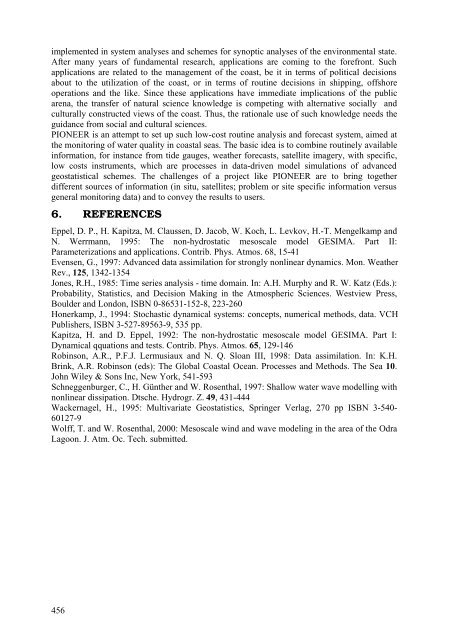EurOCEAN 2000 - Vlaams Instituut voor de Zee
EurOCEAN 2000 - Vlaams Instituut voor de Zee
EurOCEAN 2000 - Vlaams Instituut voor de Zee
You also want an ePaper? Increase the reach of your titles
YUMPU automatically turns print PDFs into web optimized ePapers that Google loves.
implemented in system analyses and schemes for synoptic analyses of the environmental state.<br />
After many years of fundamental research, applications are coming to the forefront. Such<br />
applications are related to the management of the coast, be it in terms of political <strong>de</strong>cisions<br />
about to the utilization of the coast, or in terms of routine <strong>de</strong>cisions in shipping, offshore<br />
operations and the like. Since these applications have immediate implications of the public<br />
arena, the transfer of natural science knowledge is competing with alternative socially and<br />
culturally constructed views of the coast. Thus, the rationale use of such knowledge needs the<br />
guidance from social and cultural sciences.<br />
PIONEER is an attempt to set up such low-cost routine analysis and forecast system, aimed at<br />
the monitoring of water quality in coastal seas. The basic i<strong>de</strong>a is to combine routinely available<br />
information, for instance from ti<strong>de</strong> gauges, weather forecasts, satellite imagery, with specific,<br />
low costs instruments, which are processes in data-driven mo<strong>de</strong>l simulations of advanced<br />
geostatistical schemes. The challenges of a project like PIONEER are to bring together<br />
different sources of information (in situ, satellites; problem or site specific information versus<br />
general monitoring data) and to convey the results to users.<br />
6. REFERENCES<br />
Eppel, D. P., H. Kapitza, M. Claussen, D. Jacob, W. Koch, L. Levkov, H.-T. Mengelkamp and<br />
N. Werrmann, 1995: The non-hydrostatic mesoscale mo<strong>de</strong>l GESIMA. Part II:<br />
Parameterizations and applications. Contrib. Phys. Atmos. 68, 15-41<br />
Evensen, G., 1997: Advanced data assimilation for strongly nonlinear dynamics. Mon. Weather<br />
Rev., 125, 1342-1354<br />
Jones, R.H., 1985: Time series analysis - time domain. In: A.H. Murphy and R. W. Katz (Eds.):<br />
Probability, Statistics, and Decision Making in the Atmospheric Sciences. Westview Press,<br />
Boul<strong>de</strong>r and London, ISBN 0-86531-152-8, 223-260<br />
Honerkamp, J., 1994: Stochastic dynamical systems: concepts, numerical methods, data. VCH<br />
Publishers, ISBN 3-527-89563-9, 535 pp.<br />
Kapitza, H. and D. Eppel, 1992: The non-hydrostatic mesoscale mo<strong>de</strong>l GESIMA. Part I:<br />
Dynamical qquations and tests. Contrib. Phys. Atmos. 65, 129-146<br />
Robinson, A.R., P.F.J. Lermusiaux and N. Q. Sloan III, 1998: Data assimilation. In: K.H.<br />
Brink, A.R. Robinson (eds): The Global Coastal Ocean. Processes and Methods. The Sea 10.<br />
John Wiley & Sons Inc, New York, 541-593<br />
Schneggenburger, C., H. Günther and W. Rosenthal, 1997: Shallow water wave mo<strong>de</strong>lling with<br />
nonlinear dissipation. Dtsche. Hydrogr. Z. 49, 431-444<br />
Wackernagel, H., 1995: Multivariate Geostatistics, Springer Verlag, 270 pp ISBN 3-540-<br />
60127-9<br />
Wolff, T. and W. Rosenthal, <strong>2000</strong>: Mesoscale wind and wave mo<strong>de</strong>ling in the area of the Odra<br />
Lagoon. J. Atm. Oc. Tech. submitted.<br />
456

















